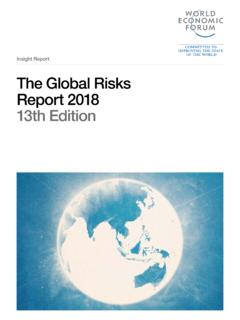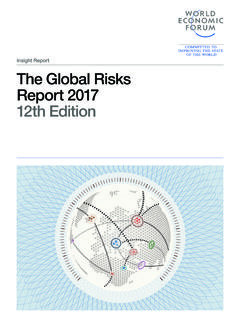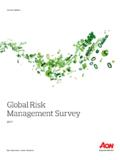Transcription of Top 10 risks in telecommunications 2014 - EY
1 Top 10 risks in telecommunications 2014 ContentsAbout this report 3 The EY risk radar 2014 : telecommunications 4 Overview and introduction 5 The top 10 risks in telecommunications : 81. Failure to realize new roles in evolving industry ecosystems 112. Lack of regulatory certainty on new market structures 133. Ignoring new imperatives in privacy and security 154. Failure to improve organizational agility 175. Lack of data integrity to drive growth and efficiency 196. Lack of performance measurement to drive execution 217. Failure to understand what customers value 238. Inability to extract value from network assets 259. Poorly defined inorganic growth agenda 2710. Failure to adopt new routes to innovation 29 Below-the-radar risks for telecommunications operators 31 Contacts 3 Top 10 risks in telecommunications 2014As the increasingly diffuse yet interdependent ecosystem of telecoms, technology and media continues to evolve, the risk universe for communications operators is changing rapidly.
2 As they formulate and execute their strategies to target and occupy parts of this ecosystem, operators have to ensure that their understanding and management of the risk to their business keeps help companies gain and apply the necessary risk insights, EY s global telecommunications Center has developed Top 10 risks in telecommunications 2014 . This is the latest in our ongoing series of periodic reports designed to pinpoint the most critical risk issues in the sector, analyze the industry s evolving responses, and highlight elements of emerging best practices in addressing these risks . As in previous reports, we do not claim that the list of risks we present here is comprehensive. Also, by its nature, it can provide only a generalized snapshot of the risks that we and the industry as a whole see at this time. Given this, we would encourage you to read this report with an open and inquisitive attitude. Are these really the risks you face in your own business?
3 If not, how and why are your organization s risks different? And how do those particular risks impact your business?This report was produced using the insights of our highly experienced sector practitioners across the world, supplemented by research and analysis from our global telecommunications Center. During the process of compiling the report, our professionals were asked to take two steps: first, evaluate the most important strategic challenges for global businesses in their industry; and second, rate the severity of these risks for their sector. This study reflects the findings from our telecoms sector evolving industry ecosystem presents many major opportunities for operators. However, each individual company s ability to understand and manage the corresponding risks will be critical to identifying and seizing those opportunities. Unless an operator s growth strategy has a solid underpinning of risk management, it will never be robust or sustainable.
4 This publication aims to help operators build and reinforce that sound this report3 Top 10 risks in telecommunications 2014 The EY risk radar presents a snapshot of the top 10 business risks in an industry sector by dividing risks into four quadrants that correspond to EY s Risk Universe model. These quadrants are: Compliance threats originating in politics, law, regulation or corporate governance Operational threats impacting the processes, systems, people and overall value chain of a business Strategic threats related to customers, competitors and investors Financial threats stemming from volatility in the markets and in the real economy The radar below plots the top 10 risks for telecoms operators on the 2014 risk 1. Top 10 risks in telecommunications 2014 The EY risk radar 2014 telecommunications 1. Failure to realize new roles in evolving industry ecosystems2. Lack of regulatory certainty on new market structures3. Ignoring new imperatives in privacy and security4.
5 Failure to improve organizational agility5. Lack of data integrity to drive growth and efficiency6. Lack of performance measurement to drive execution 7. Failure to understand what customers value 8. Inability to extract value from network assets9. Poorly defined inorganic growth agenda10. Failure to adopt new routes to innovation4 Top 10 risks in telecommunications 20141 Failure to realizenew roles inevolving industryecosystems4 Failure toimproveorganizational agility5 Lack of dataintegrity todrive growthand efficiency6 Lack ofperformancemeasurementto driveexecution2 Lack of regulatorycertainty on newmarket structures3 Ignoring newimperatives inprivacy andsecurity 8 Inability to extractvalue fromnetwork assets9 Poorly defined inorganicgrowth agenda7 Failure tounderstand whatcustomers value10 Failure toadopt newroutes toinnovationFinancialComplianceOperation sStrategic5 Top 10 risks in telecommunications 2014 Overview and introductionA world of wide regional variations.
6 The global economy has undergone a significant shift during 2013, with recovery observable in a number of advanced economies and global output set to increase at a faster rate from 2014 . While the prospect of reduced macroeconomic uncertainty is good news for operators, a number of structural pressures from regulation on core service areas to increased competition from over-the-top (OTT) players mean that market conditions remain , operating environments vary significantly between regions, driving divergent industry performance. In Europe, for example, operators are facing a mix of intensifying competition and difficulty in replicating services across borders, reducing companies ability to capture economies of scale. One of the clearest impacts of these constraints is that Europe having led the world in the adoption of 2G mobile has now slipped behind other developed regions in the migration to 4G this somber background, European telco stocks have still outperformed those of other regions since mid-2013, mainly due to investors anticipation of large-scale M&A within the region.
7 However, as Figure 2 shows, over a longer timeframe European operators shares have significantly underperformed their counterparts in other developed regions, largely as a result of macroeconomic headwinds and an uncertain regulatory landscape, coupled with the perceived risks of low profitability on wireless and enterprise 2. Telco share price development by regionSource: Capital contrast, long-term confidence in Asian telecoms operators remains buoyant, driven by strong mobile data consumption in the region s developed markets, and the substantial promise of emerging markets, where take-up of broadband capable devices and services is at a much earlier stage. Meanwhile, the telecoms industry in North America has witnessed high levels of capital intensity and rising competition but has also been innovating strongly in recent years through the introduction of new mobile pricing plans and wider service propositions for consumers and enterprises alike.
8 In Latin America, rising competition and ambitious convergence strategies are seen limiting core earnings growth, although consolidation can help create more rational market sees legacy sector positioning come under scrutinyA key outcome of the divergence in regional performance is to cast doubt on confidence in the sector s fundamental attributes. In the years since the global financial crisis, telcos have generally positioned themselves as dividend yield plays. However, a wave of dividend cuts has served to undermine investors confidence in this sector positioning in Europe, while concerns over dividend sustainability have also risen for North American operators (see Figure 3).Figure 3. Operator dividend yield development by regionSource: EY Jones TelecomsDJ Euro Stoxx TelecomsMSCI AC Asia TelecomsMSCI EM Latin America Telecoms020406080100120140160 Apr-11 Jul-11 Oct-11 Jan-12 Apr-12 Jul-12 Oct-12 Jan-13 Apr-13 Jul-13 Oct-13 Jan-14 EuropeNorth AmericaAsia-Pacific6 Top 10 risks in telecommunications 2014 Also, as operators roll out LTE networks and customer demand for mobile data continues to increase, network capital expenditure is expected to remain at elevated levels.
9 This trend could in turn support current regulatory models that view competition as a catalyst for higher-quality services at a time when many leading operators are voicing their belief in consolidation as a route toward improved economies of scale. At the same time, risks are also intensifying in the guidance-setting process for many telcos, while managing debt has become more important for many European players as they struggle to maintain profitability levels. In this light, dividend cuts have become important as ways to shore up balance sheets and preserve credit ratings. A number of ICT segments see growth potential ..This relatively gloomy environment for many operators is brightened by promising growth opportunities across a range of information and communications technology (ICT) services (see Figure 4). Some 4 in 10 mobile operators worldwide are now offering machine-to-machine (M2M) connectivity services, and enterprise demand for cloud and unified communications is increasing rapidly.
10 At the same time, ongoing smartphone take-up is driving growth in areas such as mobile advertising and payments. Figure 4. Selected ICT segments global market size and growthUS$bIn response to such trends, operators are positioning themselves to develop and pursue new use cases across a number of industry verticals. In doing so, they are addressing the perception that they have been failing to capitalize effectively on new opportunities presented by advancing but profitability remains under pressureHowever, despite the forecast double-digit compound annual increases in revenue in growth areas, margin management remains a key concern for operators. As Figure 5 highlights, return on invested capital (ROIC) measures continue to decline for operators in different 5. Operator ROIC by regionROIC (%)Source: Ovum, Analysys Mason, Gartner, NextMarket : Capital IQ, EY worrying trend reflects a number of factors including intensifying competition from low-cost providers and OTT service providers, and high capital investment required to meet rising demand for mobile data.














